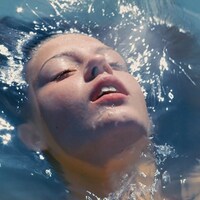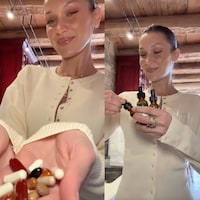We talk to the legendary drag queen and former hostess of the Chateau Marmont about beauty, identity and sacrificing the rights to her own image
You’re more likely to recognise Robert Sherman AKA Constance Cooper’s image than you might be able to place her from name alone. The now drag queen Constance Cooper, was formerly a muse of photographer Robert Mapplethorpe, and formed one half of an iconic pairing in one of the photographer’s most famous images. Though Sherman was also photographed solo by Mapplethorpe, it’s a side-on dual portrait of Robert Sherman with the late Ken Moody that placed the men within a vital chapter in the history of contemporary art.
A young Robert Sherman first crossed Mapplethorpe’s path in the late 1970s while living in New York City. Back then, an apartment in the Village cost $400 a month, and Constance, as she is now generally known, was out every night, frequenting punk clubs like CBGB’s and Max’s, wearing the “downtown uniform” of a black leather jacket and black jeans. “Studio [54] wasn’t really my scene,” says Constance. “You know, it just wasn't cool.” They met at The Mineshaft, a BDSM leather club in New York’s meatpacking district. The Mineshaft, she explains, had a strict dress code: “No collared shirts, no cologne, no sneakers, no shorts no no no no no no no. There were a lot of rules. That's probably why everyone dressed exactly alike.” For an illustration of the accepted look, see Mapplethorpe’s X Portfolio – masks and whips, leather trousers with no crotch.
“To me, that place was a curiosity,” says Constance. “I maybe went there three times in my life. Robert lived there, and had he not photographed that scene, there would be no documentation of it. There’s still a leather scene but it’s not nearly as intense as The Mineshaft was, which was very intense.”
Contrary to the shortened version of the story Sherman gives the makers of the documentary Mapplethorpe: Look at the Pictures (2016), he didn’t go home with Mapplethorpe to be photographed on that first night. Though he got the photographer’s phone number, he did not take him up on the request at first. “I didn't want to end up in a sling with a whip up my ass, you know.” Instead, she filed Mapplethorpe’s number away into a drawer of “tricks” and thought nothing of it until someone else, who had the sense of what Mapplethorpe might become, urged him to follow up.
“I went home with this guy and he had a Polaroid that Robert had given him and he knew that Robert was going to be somebody; there was a buzz even before people knew who he was,” explains Constance. “He said, ‘You’re nuts. You better find that number, or you better camp out at The Mineshaft and see him again because he's going to be famous and you're going to regret it!” So he did, and Mapplethorpe shot his first photographs of Sherman in January 1979, according to the release forms now held in the Getty archives.
Constance believes it was her alopecia, which she had had since childhood, that piqued Mapplethorpe’s interest. “If I had had hair I don't think he would have looked at me twice because I wasn't into leather, he wasn't going to photograph me like the leather shots, the people doing those things.”
“Growing up hairless, you think you're the freak of the world. A model is like the last thing you would ever imagine [becoming],” says Constance, but in New York’s club scene this unusual attribute became an asset, grabbing the attention of the door pickers, legendary gatekeepers responsible for ensuring the right mix of people entered the club. “I remember distinctly a club called Area which was very popular – Warhol used to go there all the time and they had performance art in there. When it opened there was a huge mob of people waiting to get in, and my friend just knew and said to me ‘take your baseball cap off so the doorman sees you’, which I always wore since a child because you need it to protect you from the elements. And as soon as I took it off he just pointed right at me and got me in.”
Years later, as Constance developed an interest in drag, she found that she didn’t get noticed – or photographed – nearly as much when in a wig. “I just thought that's because when I wear a wig I look like every other drag queen, but I've got my own look, and I was the only bald drag queen. I mean, Leigh Bowery in London did it but that's it. Now with Ru Paul's Drag Race, all these kids are doing it.”
Constance says she happened upon drag “by accident”. Her boyfriend was friends with the cult San Francisco drag figure Doris Fish. On one visit to New York, Fish – inspired by Constance’s alopecia – said: “You don’t do drag? You don't do drag at all? You don't shave your legs. You have no hair on your legs and you don't shave your face,” and proceeded to make Constance up right then and there, putting her in a platinum blond wig and a negligee.
The experience was transformative for Constance in several ways. Growing up in Connecticut during the 1970s, where yearbooks are a catalogue of long middle-parted hair for both girls and boys, young Robert Sherman was mercilessly bullied by classmates, who threw around names like “baldy” and “Mr. Clean”, referring to the bald-headed Procter & Gamble mascot. For decades, Constance was unable to change her look – “not even a five o’clock shadow or a haircut”. But Fish’s makeover showed her she “didn’t have to be stuck like this,” and opened up a world of opportunity for the looks she could create and the people she could be. Constance started doing drag shows in San Francisco in 1980, and then back in New York, getting gigs as a go-go dancer in the city’s thriving night scene at clubs like The Roxy, The Palladium, Club USA, Limelight – “you name it! All of them!”
Sherman had modelled for Mapplethorpe for several years when the photographer asked for help finding a black man who also had alopecia. “I told him that there aren't many of us around, we're not very common – we're a rare breed,” says Constance, but Mapplethorpe found Ken Moody relatively quickly in 1984. “And we did the famous shot, and many others, everything with two bald heads you could do, we did. And then that was the last of it.”
The famous black-and-white photograph features Robert Sherman in the foreground resting his neck over the shoulder of Moody. Both men nude, Moody’s black skin and Sherman’s pale skin together create a sublime example of Mapplethorpe’s signature – simple graphic form captured in beautiful contrast. What looks iconic, also felt symbolic to many commenters, with art critics postulating on the meaning behind Moody’s closed eyes, apparently connecting him to his subconscious, and Sherman, the white man, eyes open, in refusal to engage with his.
“Robert was just not deep like that,” says Constance. “Anybody that knows his work knows it's all about form and structure and that's what it is. They try to read all this but you know why Ken's eyes were closed and my eyes were open was, as Ken said, he blinks a lot. The man blinks like crazy…And yeah, [Mapplethorpe] took a shot with Ken in front and took the Polaroids and then he put me in front and it just worked out better – Thank God! I think that was rough on him when that picture turned out to be hugely famous and he's in the back.”
Constance left New York for Los Angeles in 1994, at a time when it felt like the city’s heady nightlife she existed in had dwindled. Having acquired a SAG card in New York, Constance’s early days in Hollywood came with a disappointing reality check for the aspiring actor. She recalls being at a Warner Brothers set and speaking to the person taking her to the location: “I was so fresh and new and I said, ‘I have this look that is very unique and I'd be perfect for, like, Star Trek movies or science fiction, or you know, things like that.’ He said, and I'll never forget it, ‘That's why we have hair and make-up departments. We can make anybody look like anything.’ ‘Oh, well,’ I said, ‘I just gave up my apartment in New York and now you've crushed my dreams’.”
But work and a fame – of sorts – would come another way. A friend of Constance’s, André Balazs, who had purchased and restored the legendary Chateau Marmont Hotel in 1990, planned to open the Marmont bar, and was looking for entertainment that would evoke its heady history. Constance Cooper, Sherman’s drag persona, made-up with the heavy, precision-lined lids not dissimilar to a 1930s Joan Crawford, always completing the look with ostentatiously dangling ear chandeliers, became hostess and gatekeeper to the drinking den’s coveted 15 tables. “So that's how I made my entrance!”
Constance Cooper held court during a renaissance period in Hollywood nightlife. Pre camera-phones “people got a lot more loose – the things I could tell you,” she says. “Meeting all the celebrities was fun, and hanging out with them. Everyone was there, George Clooney, Matthew McConaughey, Colin Farrell, when they were crazy and wild and drunk and out of control.”
Proximity to Hollywood power players gave Constance several opportunities, and landed her roles in music videos for Depeche Mode, Madonna, Smashing Pumpkins, and Radiohead, where her unusual appearance felt subversive. Her casting for a starring role in the video for Christina Aguilera’s Grammy-winning song Beautiful, carried a different message. No longer the alt outsider, Constance was presented as having a legitimate beauty of her own.
Constance’s image also made it onto the screen in a more unexpected way, when one day she found that television show American Horror Story had created a series set entirely in a hotel, and one of the characters, played by Denis O’Hare, was a bald drag queen who hosted the bar. Constance was shocked. “How many bald drag queens are a fixture at a hotel bar? You name one! You can see the coat he was wearing. I even had a coat that was exactly like that.”
The drag queen frequently saw the show’s writer Ryan Murphy at the Chateau, and recalls one of their last interactions: “I'd always be floating around the hotel garden; I'd leave the bar and just walk around so people could see me, you know. And the last time I saw him, I was walking through the garden and I saw him and said ‘hello’, and he said, ‘What are you doing over here, showing off?’ and I said, ‘Yes, how did you guess?’”
“Credit would have been nice, a cheque would have been nicer,” says Constance, who has decided to consider it a “homage”. Contemplating how her image has proliferated, once again, far beyond her control she says, “I'll take the Mapplethorpe fame over that TV show any day. The Mapplethorpe images will live on forever.”
Constance recalls a moment at the party the Getty held for the acquisition of Mapplethorpe's archive material: “One of the bigwigs at the museum said to me, and I'll never forget, ‘So what do you think of your new home for the next 200 years?'” Donated by the Robert Mapplethorpe Foundation, the Robert Mapplethorpe archive housed at the Getty Research Institute contains dozens of Polaroids, and more than 200 unique works of art, including drawings, hand-painted collages, and assemblages, some of which combine found objects with photographs.
Though she laments selling her Mapplethorpe works for a fraction of their worth many years ago, Constance reconciles this and other disappointments with the pivotal role the image she is a part of has played in cultural history.
When Mapplethorpe first began creating photographic work, the practice of photography was not necessarily considered an art form, and certainly did not have comparable price tags. Not even photographers themselves could have predicted how the market would develop. Annie Leibovitz jokes about how rich she’d be if she’d kept everything Mapplethorpe gave her in Look at the Pictures.
There were critics who considered Mapplethorpe’s homoerotic work not only ‘not art’, but obscene – the argument put forward in a 1990 court case that came about when the Contemporary Arts Center in Cincinnati put on an exhibition of Mapplethorpe's work. The acquittal of Mapplethorpe’s defendants was a major reaffirmation of the First Amendment freedom of speech protection, newly applied in the realm of homosexual art. That art institution The Getty would deign to archive this work for centuries was symbolic not only of the canonisation of photography as fine art, but the changing attitudes towards homosexuality and its artistic expressions.
“Robert sought to elevate aspects of male experience, to imbue homosexuality with mysticism,” wrote his friend, former lover, former roommate and occasional collaborator Patti Smith in her memoir of their relationship Just Kids.
Throughout her life, Constance’s unconventional looks have provided both challenges and opportunities, and ultimately shaped who she is. That the Mapplethorpe photograph is inextricably linked to significant events in cultural history provides her with a kind of vindication. “That's the thing that I appreciate the most, that my images will go down in history, till the end of the time. Be as famous as you want but there's nothing like being a part of a museum.”




